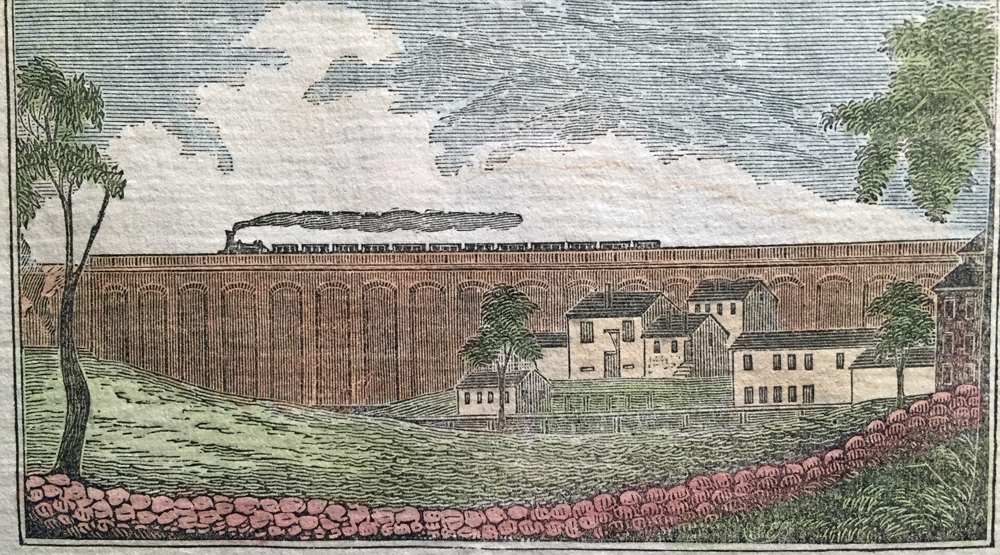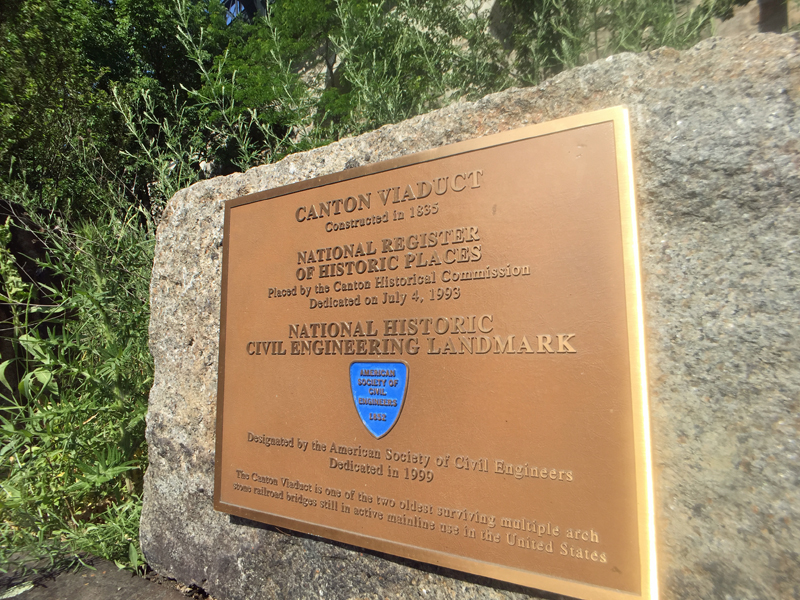True Tales from Canton’s Past: The Western Wall
By George T. ComeauWhen the new condominiums on Walpole Street were built, a plan was conceived to help beautify Viaduct Park with privately planted trees and flowers. And for a while at least, it was a charmingly planted space. Flowers bloomed and the grass was tended. The town’s capable and talented Department of Public Works cleared the river and the bridge of all the poison ivy and vines. The park is a fitting tribute to the men who built one of the finest 19th century railroad bridges in America.
Take a look today at this forlorn and neglected site. The trees have overtaken the view of the magnificent stone pillars. The grass is unkempt, the bushes untrimmed, and weeds now choke any view of water passing under the arches. In any other town, there would be a constant and vigilant undertaking to present this site to the world as a critical story tied to our history. This author has long argued that without the railroad, Canton would have been a far different town today.
Because of this bridge, we can point to the fact that Paul Revere’s copper rolling mill became a success. We know that the Irish blood and sweat on the stone of this bridge helped form the roots of the Irish Catholic church in this town. The Viaduct allowed industry to boom, and then supported the three major war efforts that this country endured. Put simply, the Viaduct is Canton’s most enduring and lasting symbol of man’s dominion over nature.
This bridge is our most lauded and celebrated historic site. We tend to take it for, well, “granite,” but in fact it is truly an engineering marvel. Built by Scottish Freemasons, it was constructed almost entirely by the hand of Irish laborers who came here for work and helped establish one of the earliest communities for this immigrant class. The stone was quarried locally, and the engineering was done on site as the bridge design conceived. No original plans of this bridge have ever surfaced, and the men who built it took several secrets to their graves.
At the same time, in the age of the Internet, new and exciting discoveries await in long lost archives. Perhaps some day we will learn why the structure is hollow and how exactly the blind arcade walls were built to such a fantastic height in what was then swampy riverbanks. Some riddles of the park and bridge are easily solved, like the naked lady carved in the top of the rock that sits near the center of the park. Go and take a look and see her for yourself. And other mysteries are simply urban legends, like the one that was shared recently that told of a door under the water that gave access to the inside. Not so! The only access inside is through the removal of a stone in one of the arches. Only a small handful of locals have ever been inside the Viaduct. This writer is proud to say that he has surveyed the interior. And Betty Lethin, the former town public health nurse, is the only Canton female to have ever been inside.
The earliest image of anything we have of this town is that of the Canton Viaduct. There are twin prints of the bridge, complete with bucolic cows grazing in a meadow nearby. The engravings were likely commissioned by the firm of Dodd and Baldwin to celebrate the fact that they were in charge of the construction in 1834. And there is another celebrated view that was drawn sometime around 1837 that is perfect in so many ways. It is a quaint little woodblock engraving done by John Warner Barber and published in a book entitled “Historical Collections being a General Collection of Interesting Facts … relating to History and Antiquity of Every Town in Massachusetts.” The book featured 200 engravings. And when it came to Canton, the Viaduct is depicted in romantic detail.
Barber, who was from East Windsor, Connecticut, actually came to Canton to see the bridge for himself as he traveled from town to town for his work. He would have made rough pencil sketches to aid his memory when later he carved into wood the scene depicting this marvel. Of Canton he writes, “The following is a westerly view of the viaduct in this town, on which passes the Boston and Providence railroad. It is constructed of granite, and is 600 feet in length, 63 feet above the foundation, on 6 arches, with a succession of arches at the top.” Barber was close in his estimates; the bridge is actually 615 feet long and 70 feet wide, making it, at that time, the longest and tallest railroad viaduct in the world.

Southwestern view of the Canton Viaduct by John Warner Barber, drawn around 1837 (Collection of the author)
Barber wrote further of the Viaduct and his scene, “It is an admirable piece of workmanship, and cost the company $80,000. On the right of the engraving is seen the northern extremity of the stone factory, a large establishment for the manufacture of cassimeres, which, when in full operation employs between 300 and 400 hands. The copper works of Mr. revere, near the above, is an extensive establishment; all kinds of copper are manufactured.”
At the time this description was written, there were just over 2,000 people living in what was becoming a manufacturing center. The Viaduct was at the core of the transportation system, and people here were in awe of this massive structure. There is a crude pencil drawing in the collection of the local historical society, spuriously attributed to “Revere,” that also depicts a similar view of the Viaduct. There is little doubt that the western wall, now hidden by trees, is the more pleasing and accessible view of this site.
And finally, a small booklet has just been discovered by this writer that is the quaintest telling of the story connected to the Canton Viaduct. Entitled “First and Last Poetical Impressions of the Boston and Providence Rail-Road,” it was printed in 1837, just two years after the bridge was completed. “Canton Babel comes to view, which does most men astonish; Each other’s speech they hardly know, ‘Mongst Yankees, Dutch and Irish. I almost thought it was the road that led right on to heaven — and nearly thought there was no need of having sins forgiven. I’ve priz’d this bridge from butt to butt (when viewing it at leisure), a thousand dollars for each foot, to reckon it long measure. The length I call five hundred, the height nearly twice twenty, under the arch two teams can meet, with pass room rather scanty. An arch is built for the old road, with granite stone concaved; the people that near here abide, have much of sunshine saved.”
This rare poem, taken together with the woodcut and drawings, help us understand the awe that man felt at sensing that this was indeed a major feat of engineering. Likened to the pyramids, the Viaduct was a proud symbol of the strength of the railroad and the industry that built Canton.
This is a National Historic Site and is on the Federal and State Register of Historic Places. The challenge to our town fathers today is clear: help guide the tending and maintaining of this park. Restore the glory of the space for all to see and celebrate. Cut back the trees; reveal the stones carved with the marks of these master craftsmen. Open the view to the water; preserve the western approach so that the children of today can also see the work of those who built the place they live today. It is the small things, the tending to the grass and weeds that remove the sense of neglect and create a space of dedication to our town’s place in this nation.
Short URL: https://www.thecantoncitizen.com/?p=33651











